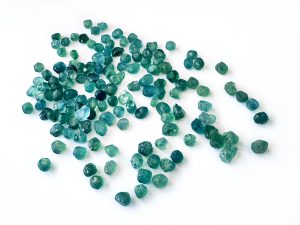With photographs by Wimon Manorotkul and E. Billie Hughes
One interesting feature of the corundums from the Pailin area is the virtual absence of colorless, yellow and green sapphires. Local diggers only occasionally find a yellow stone; the other varieties are not found at all. Star sapphires have been found at Pailin but are rare. Zircon and pyrope garnets are found, in addition to corundum.
BO PLOI, KANCHANABURI, THAILAND
When Pailin was ceded to French Indochina in 1907, Thailand lost its key source of quality blue sapphires. This was compensated for, to some degree, by the output from Bo Ploi, in Kanchanaburi Province, better known as site of the famous World War II “Bridge on the River Kwai.”
In 1918, blue sapphires were discovered near the town of Kanchanaburi in western Thailand. This created a minor gem rush, and the small town of Bo Ploi was founded near the mines. Not much was found in the first few years, but in early 1929 rich finds were made in the northern part of the field, with mining output exceeding $3,000 during the first few months of that year. Over 100 sapphires mined, weighing more than 3,300 ct, were valued at $4,250. Later,however, the mines were abandoned, believed to be exhausted. Mining did not recommence until well after World War II.
In 1978 a new find was made 6 km north of Bo Ploi, at Ban Chong Dan, and several hundred people, including some large operators, started mining there. Shortly thereafter Bo Ploi become Thailand’s major source of blue sapphire, especially for large stones.
The Bo Ploi deposit lies about 30 km north of Kanchanaburi town and consists of a group of low basaltic hills covered by large boulders. Weathered basalt forms a characteristic red soil which has accumulated at the foot of the hills. In this soil are found black spinels (magnetite – strongly magnetic), which are locally termed nin (นิล) and are faceted into inexpensive gems. Sapphires are rarely found attached to the basalt matrix; most are mined from eluvial and alluvial deposits.
The mines of Bo Ploi and its surroundings produce mostly blue sapphire, along with the occasional yellow, pink and black star sapphire. Gühler described them thus:
Very transparent [actually they are somewhat milky] with perfect color; reddish tints are rare. Lighter colors are more frequent. Large specimens are frequent. Rather less flaws than Pailin, except zonar striations which are very
This magnificent matched pair of Bo Ploi sapphires is an example of some of the finest ever produced in the Land of Smiles. With this deposit nearing depletion, such stones will become highly collectible. 80.15 ct total weight. Sant Enterprises; WM
LEFT BRAIN: RUBY & SAPPHIRE PRICES

With the exception of imperial jadeite and certain rare colors of diamond, ruby is the world’s most expensive gem. But like all gem materials, low-quality (i.e., non-gem quality) pieces may be available for a few dollars per carat. Such stones are generally not clean enough to facet. To date (2013), the highest price per carat ever paid for a ruby was a 6.04-ct Burma stone which sold at Christie’s Hong Kong for US$3,347,042 ($554,146/ct). The auction record total for a single ruby was the 32.08-ct Hope ruby, a Burmese stone that sold at Christie’s Geneva for $6,742,440 ($210,000/ct).
As for sapphire, it is historically about a quarter the price of ruby, but stone sizes can be far larger. The per-carat auction record for a sapphire was set at Christie’s New York in 2012, when a Kashmir blue of 8.91 ct was hammered at US$1,370,500 ($154,,000/ct). In terms of total price, the auction record holder is a 130.50-ct Burma sapphire, which sold at Christie’s Geneva in 2011 for $7,122,742 ($55,000/ct).
RIGHT BRAIN: WHAT PRICE PLEASURE?
Prices of Genuine Jewels
The prices of jewels are not stable. There is no law governing their prices, and there is no reason why these prices should not fluctuate with time and place. Each country, each nation carries its own temper.Furthermore, at one time nobles begin to sell them off and at others, to stock them. Stones are plentiful at one time and scarce at another. God grants honor to some and disgrace to others.
– al-Biruni, 11th century AD
Kitab al-Jamahir fi Ma‘rifat al-Jawahir
Market Factors
One of the great mysteries for novices is understanding the relationship between price and quality. In a perfect world, price would directly relate to quality/weight/rarity. Unfortunately, Planet Gem is far from symmetrical. Market factors can have as much, or even greater, impact on prices, as does quality.
Just a few of the market factors that influence price include:
• Market supply vs. demand: Items that are plentiful and/or in low demand will be cheaper than those that are rare and/or in high demand.
• Seller’s financial situation: Sellers who need money will obviously be more flexible on price, and vice versa.
• Seller’s business overhead: Prices can vary dramatically depending on the seller’s overhead. A cup of coffee purchased by a street vendor may cost only a few cents; the same cup of coffee at a 5-star hotel in the same city may cost 10–20 times more, due to the higher overhead.
• Buyer’s financial situation: Buyers whose businesses are prospering are often willing to pay higher prices.
• Buyer’s sales prospects: Buyers who have a customer waiting for an item are often willing to pay higher prices.
• Buyer/seller personal relationship: No one likes to do business with unhappy or abusive people. When the buyer and seller enjoy each other’s company, they often make special provisions for one another.
• Personal situation surrounding the sale: The author has seen buyers pay above-average prices for goods for a variety of reasons. These have ranged from trying to impress one’s girlfriend, to buying something simply to prevent a competitor from purchasing the same goods.
• Bidding wars: Where two people are competing to purchase the same item (which frequently occurs at auction), emotions may force the price far beyond reason.
Throughout this book I reference auction prices. Not because they represent the highest prices paid, for they don’t; the finest gems generally trade hands in private sales at prices above the auction market. I reference them because the auction market is an open reflection of the world gem market. Unlike real estate, gems can and do travel, and therefore have a worldwide value. While auction prices do not always accurately reflect the market (due to bidding wars, etc.), they are public, and thus useful for those wishing to better understand prices. But they are not the only tool. Collectors should not just visit auctions, but also the offices of dealers and jewelers. Dip your spoons into as many bowls as possible. In this way you will begin to develop a taste for pricing.
Pleasure Points
On the opposite page you will find a sober essay on the value of ruby and sapphire. It is based on statistical data and can be fully defended on that basis. It’s a left brain analysis.
This page presents a contrarian view. If you view gems on the basis of price per carat, you are effectively purchasing a commodity. A refined product, something no different from rice, wheat, silver, lead or gold.
For several hundred years, gems have been sold on this basis, by formula – Tavernier’s Law – an attempt to create an equation that will reduce the beauty of a man or woman, a sunset or mountain vista to simple math.
I confess that I once thought this possible, despite the admonishments of my elders.
Having now reached gray beard status, I understand that beauty is completely subjective. Taste is likewise. While a society or subset of a society’s taste can have an impact on value, for the collector, what is most important is to follow one’s heart.
A while back, a friend told me that, despite all the fine gems he had sold, he never had a retail client ask about the price per carat. His clients were only focused on the item and its total cost.
We in the trade are obsessed with price per carat; we pore over differences in inclusions that only a microscope can see, and place significantly higher values on one-carat stones, to the detriment of those that are only 0.99 points. Ask yourself this. Have you ever seen a gem worn on a scale? We deal with some of the most spectacular creations of nature and yet we treat them in banal fashion; they might as well be coffee beans.
A stunning suite of unheated Sri Lankan sapphires, displaying the cornucopia of color that this gem is capable of. The creation of such a set often involves collecting stones over a period of years or even decades. Only the most passionate dealers and jewelers will go to the lengths necessary to produce sets to this degree of opulence. In the world of jewelry, they represent a huge investment. But when the right patron and artist join hands, the result can be akin to the Sistine Chapel. 2.5 to 11.71 ct each; 108.72 ct total weight. Sant Enterprises; WM
When a fine gem is found, its value can be multiplied if paired with another gem (or gems) of similar appearance, shape, cut or size. If the individuals that make up the set are hard to find and of high quality, the matched set is always more valuable than the individual stones on their own.
The multiplication factor increases greatly with the size and rarity of the gems in question. When it comes to untreated ruby, anything above a carat that matches is unusual. When the size of such stones exceeds two carats, the rarity factor becomes unbelievable. Don’t believe me? Try to find two untreated rubies in any collection anywhere in the world that truly match in terms of cut, shape, size and appearance. Good luck!
Thus when we judge pairs and even suites, we must be far more generous. The finest qualities will almost never be found in multiples. Almost.
When it comes to pairs and sets, a number of decisions must be made. There is a basic conflict between business and beauty. Striking the balance is key to making money. But occasionally someone has the vision to throw caution aside and reach for that which is most beautiful. Such pieces are a marvel to behold, even while representing fiscal insanity. History is replete with examples. Think Taj Mahal here.


